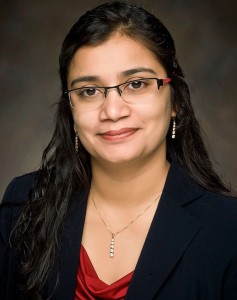
Priti Parikh, assistant professor and director of research in the Boonshoft School of Medicine Department of Surgery.
When a severe accident happens, every minute counts, and getting the victim to the correct trauma center becomes critical.
While most injuries can be treated at local emergency departments, those who are severely injured should get care at a Level I trauma center. By doing so, the risk of death is decreased by 25 percent.
The Wright State University Boonshoft School of Medicine Department of Surgery is working to ensure that happens with the help of a $56,126 research grant the department received in July from the Ohio Department of Public Safety to help improve patient triage at roadside accidents.
“Over-triage and under-triage errors affect the efficiency of the trauma system,” said Priti Parikh, Ph.D., assistant professor and director of research in the Department of Surgery and the project lead.
A collaboration of researchers, clinical faculty members and engineers, the team includes Randy Woods, M.D., Melissa Whitmill, M.D., and Kimberly Hendershot, M.D., in the Department of Surgery, and Pratik Parikh, Ph.D., in the Wright State College of Engineering and Computer Science.
Over-triage occurs when less injured patients are transferred to a Level I or II major trauma center. Under-triage happens when severely injured patients are transferred to a Level III or non-trauma center.
“These errors occur likely due to criteria emergency medical services personnel use for triaging patients at the site of an accident,” Parikh said. “Our discussions with emergency medicine physicians also confirmed this. They transfer patients to other hospitals based on their clinical conditions and injuries.”
In addition, over- and under-triage rates play a significant role in trauma care costs.
“Such errors impede patient care access and safety,” Parikh said. “Those triage errors place a huge cost burden on hospitals because of increased length of stay, readmission or mortality.”
“More efficiently matching patients’ needs to hospitals’ resources and capabilities is vital to improving the trauma system,” Parikh said.
Her team of researchers and surgeons will study over- and under-triage rates for the state using historical data and develop and validate a new triage model.
“We strongly believe that our study will not only address several concerns related to on-field trauma triage currently discussed within the state of Ohio, but also will lay a strong foundation for building an analytics framework to address these concerns,” she said.

 Wright State, Premier Health hosting surgical symposium for high school and undergraduate students
Wright State, Premier Health hosting surgical symposium for high school and undergraduate students  Wright State joins nation in celebrating first-generation students
Wright State joins nation in celebrating first-generation students  Education grant connects Wright State students with Dayton Regional STEM School for instructional education partnership
Education grant connects Wright State students with Dayton Regional STEM School for instructional education partnership  Wright State recognized among top public universities in latest U.S. News Best Colleges Rankings
Wright State recognized among top public universities in latest U.S. News Best Colleges Rankings  Nearly 1,000 students and alumni turn out for Wright State’s Fall Career and Internship Fair
Nearly 1,000 students and alumni turn out for Wright State’s Fall Career and Internship Fair 